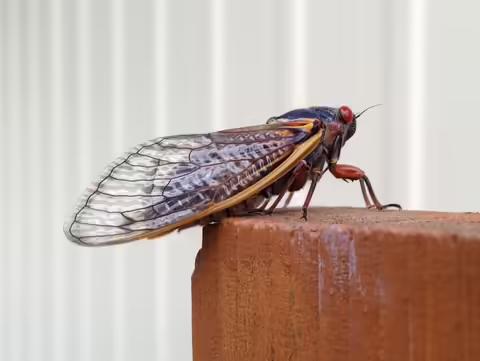Four years ahead of schedule, two large groups of periodical cicadas are beginning to emerge throughout Illinois. In a time of pandemic and social unrest, the appearance is another surprise in a spring ripe with unexpected twists.
Periodical cicadas are already beginning to emerge throughout Illinois and will continue to emerge until late-June. University of Illinois Extension provides additional information in its online Home, Yard, and Garden newsletter
“A periodical cicada emergence can be an exciting event to witness,” says Sarah Hughson, Illinois Pesticide Safety Education Program. “This year, two large broods are emerging four years early and will encompass much of the state, so many people may be able to watch this special event in their own yards.”
Brood XIII includes three species of 17-year cicadas emerging in northern Illinois and parts of central Illinois, and Brood XIX includes four species of 13-year cicadas emerging in southern Illinois and parts of central Illinois, says Hughson.
Cicada nymphs live below ground for most of their lives, sucking fluids from tree roots, unnoticed until they emerge. When the emergence begins, cicada nymphs leave the soil, climb a few feet up a tree or shrub, and molt to their adult stage, leaving their shed skin behind.
Adult cicadas usually remain near their molting site to allow their bodies time to harden, before moving farther up the tree, says Hughson. As adults, periodical cicadas feed very little, devoting their time to reproduction.
Adult males will call to females with a shrill buzzing song. “In areas with low populations of cicadas, the calls can be a nice summer chorus, but in areas with heavy populations, some may find the calling quite loud,” Hughson says.
Injury to trees and shrubs
After mating, female cicadas use their ovipositor, an egg-laying structure, to cut small openings and deposit eggs into twigs and branches. They may repeat this several times on a given twig, resulting in scars several inches long. Leaves growing beyond the scarring site often die and twigs may break easily.
Female cicadas prefer to deposit eggs in twigs and branches that are 0.25 to 1.5 inches in diameter but they may also deposit eggs in the trunks of small transplanted fruit or ornamental trees, so it is important to identify and protect trees that may be at risk for injury, Hughson says.
Protecting trees and shrubs
In areas with heavy periodical cicada populations or areas with young or cherished fruit and ornamental trees, action can be taken to prevent injury, says Hughson. “The best way to protect small trees from damage in areas with heavy cicada populations is to surround the trunks with screening to prevent egg-laying.”
Waiting to plant small trees or choosing larger trees at least 2.5 inches in diameter can help avoid damage from egg-laying. For small fruit trees, consider covering trees in mesh no larger than 0.25 inch while the cicadas are active to avoid egg-laying.
Applications of insecticides may kill many emerging adult cicadas, but research has found that the applications did not reduce the amount of egg-laying or injury to the plants, Hughson says. “Remember your local wildlife, including birds, mammals and reptiles, will be feasting on cicadas throughout the emergence,” she says. “Choosing cultural controls and avoiding chemical treatments can prevent wildlife from consuming pesticides along with their meal.”
Most areas do not see heavy populations of periodical cicadas and do not require significant action to protect trees. “Periodical cicadas require 13 to 17 years continuously feeding on the same tree to complete a single generation,” Hughson explains, “so areas where trees were removed or areas that were previously farmland or prairie may see very few if any periodical cicadas.”
Which counties will likely see periodical cicadas? According to Cicada Mania, the following counties will be impacted.
Brood XIII: Northern and central Illinois counties that may see 17-year periodical cicadas include Bureau, Carroll, Cass, Cook, DuPage, Fulton, Grundy, Henderson, Henry, Jo Daviess, Kankakee, Lake, LaSalle, Livingston, Logan, Marshall, Mason, McHenry, McLean, Menard, Peoria, Putnam, Sangamon, Stark, Tazewell, Whiteside, Will, Winnebago, Woodford.
Brood XIX: Southern and central Illinois counties that may see 13-year periodical cicadas include Adams, Brown, Calhoun, Cass, Champaign, Clark, Clay, Coles, Cumberland, De Witt, Effingham, Fayette, Ford, Franklin, Gallatin, Hamilton, Hancock, Iroquois, Jefferson, Johnson, Marion, Massac, Moultrie, Pike, Pope, Saline, Shelby, Vermillion, Washington, Williamson.
SOURCE: Sarah Hughson, Illinois Pesticide Safety Education Program, University Of Illinois
EDITOR: Judy Mae Bingman, Marketing and Communications Manager, University of Illinois Extension
